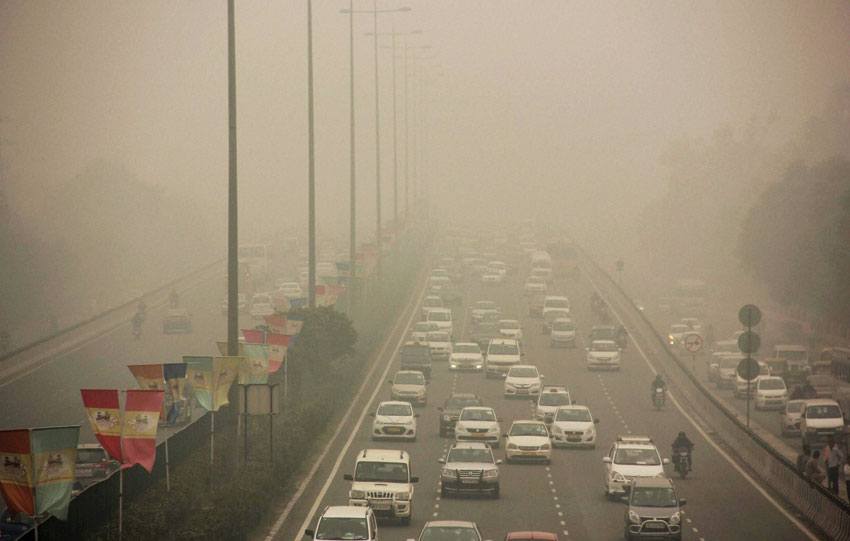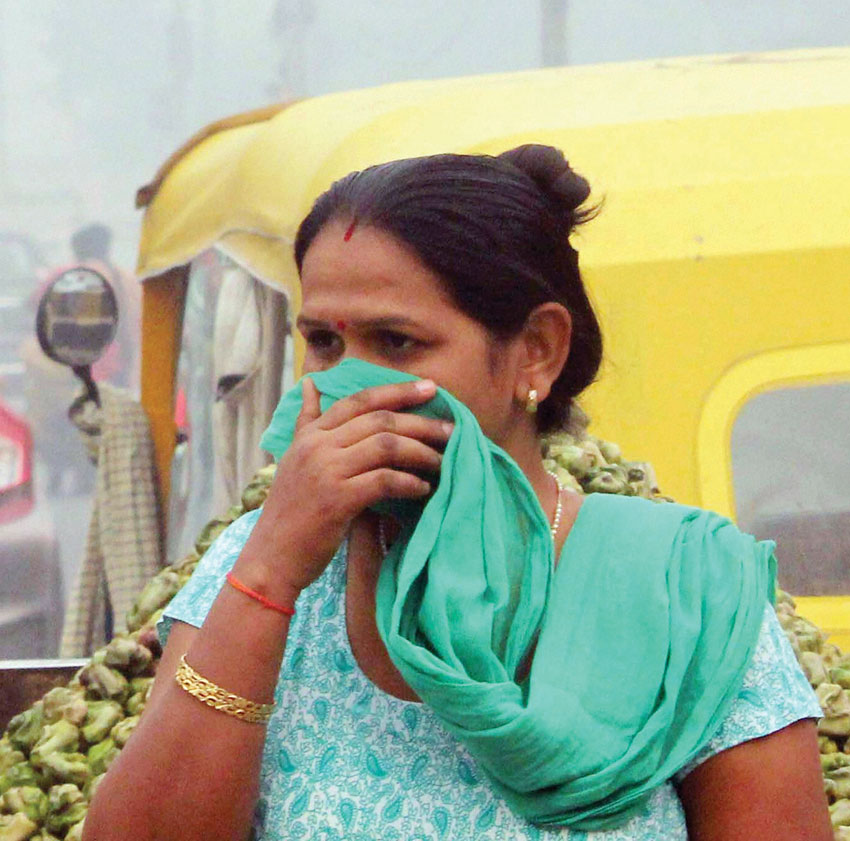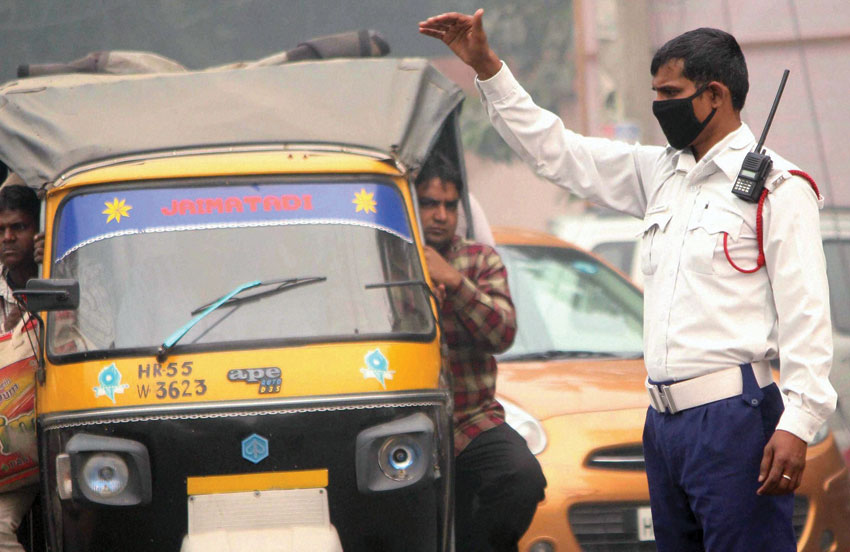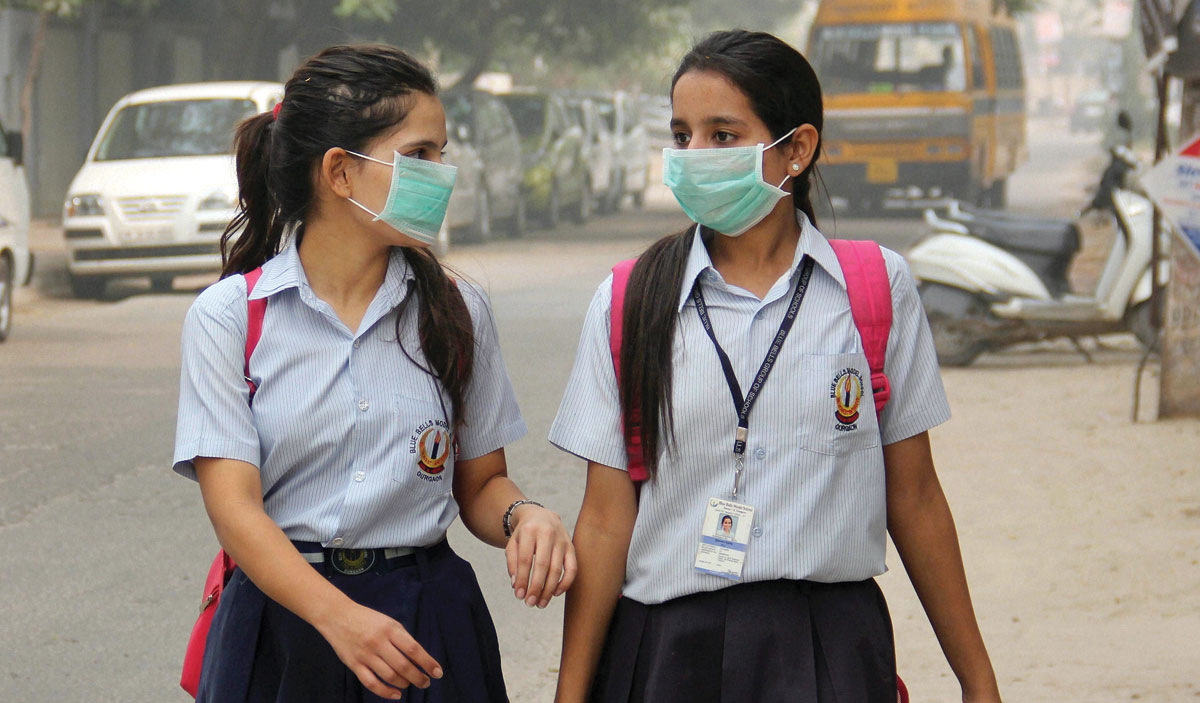THE TOXIC AIR HANGOVER
School girls wearing anti-air pollution masks as protective gear after pollution reached hazardous levels in Gurgaon, Nov. 5. (Press Trust of India)
The morning after the immense lighting and fireworks night, India, already reeling with a severe air pollution problem, woke up to unclean, choking airs whose quality dipped to dangerous levels that harm respiratory health in normal people and severely debilitate those with illnesses, writes Priyanka Bhardwaj. – @Siliconeer #Siliconeer #India #Pollution #Righttobreathe #Delhiair
The worst affected regions were the northern parts of the country where winter has started creeping. More than a third of the 29 cities monitored by the Central Pollution Control Board (CPCB) were choked by particulate matter pollution—concentrations of fine particulate matter upped to the Air Quality Index (AQI) reading of 384 for Agra, 385 for Ahmedabad, 428 for Faridabad and 445 for Delhi.
If any place deserved to have a rating of AQI of 100, limit for good air quality, it is yet to be ascertained.
In the southern and western areas, cities such as Bengaluru, Mumbai and Chennai experienced ratings of “moderate” to “satisfactory.”
Hyderabad shone alone as its air quality improved from “poor” to “satisfactory” as compared to last year’s.
According to the System of Air Quality Weather Forecasting and Research, a research unit run by the Indian Institute of Tropical Meteorology based in Pune, concentrations of PM2.5 (particulate matter 2.5 micrometers and smaller) and PM10 have been reported.
Some studies suggest that air quality had started declining to “poor” since Oct. 27 due to an additional weather pattern, an ‘anticyclone’ that prevented dust and particulate matter from escaping off the immediate surface air.

These readings lend further credibility to the latest report from UNICEF that stresses on impending health risks to approximately 620 million children residing in South Asia, with an air quality six times worse than the standard suggested by the World Health Organization, of the total 2 billion children worldwide.
UNICEF notes 600,000 children die each year due to air-pollution related diseases and many more suffer from respiratory diseases.
While toxicity affects everyone it is shockingly harmful to children whose physical and cognitive developments are still in progress and breathe twice as quickly, taking in more air in relation to their body weight.
In New Delhi, the national capital, air pollution is constantly been on the downslide with the dipping of temperatures, and burning of garbage and leaves, to provide warmth for winters, this is only expected to worsen.
In their fight against pollution the city’s civic authorities have banned plying of cargo trucks on city streets, barred older cars that fail specific emissions standards and in previous months carried out several weeks of “odd-even” numbered plying of vehicles on alternate days that had only led to traffic control without controlling pollution.

Some reasons may be to do with the poor implementation of measures such as the ban on burning of waste and leaves, construction dust and cooking fires fuelled by wood or kerosene.
Based on NASA image of Oct. 26, the Delhi government pointed the blame of the air pollution in the capital on the practice of farm stubble burning (biomass burning) in Punjab and Haryana.
In a first one of sorts the Delhi government has launched of a smartphone application named “Change the Air” (Hawa Badlo) whereby citizens can lodge complaints of pollution norms along with images.
During Diwali the government tried to inform the public of the hazards of firecrackers but this effort was washed down by the festive spirit that was evident in the millions of crackers lighting up the skyline.
Center of Science and Environment (CSE) that often works with the Delhi government in matters related to environment is of the view that as soft messages are largely ignored it is time to drive home message with some hard-hitting health advisories.
The scientific body suggests the country as a whole could take a leaf from the chapters of controlling pollution by China and the UK where emergency measures including heavy penalties are promulgated as soon as air quality is measured as “poor.”
Ample evidences reveal the link between air pollution and heart attacks, strokes, arthritis, lung cancer and other respiratory issues.

Perhaps not many realize that if the fall of AQI continues unabated India would easily slip below Beijing’s red alert category when the Chinese capital had to close down its schools and industries, reduce power plant emissions and severely restrict car usage.
Now at their wits end on how to get the situation under grip and the National Green Tribunal demanding accountability, the Aam Aadmi Party government in the capital has come up with the idea of installation of air purification units, mist fountains and virtual chimney at five major traffic intersections—Anand Vihar, ITO, Sarai Kale Khan, Kashmiri Gate and IIT (Delhi) or AIIMS—on an experimental basis.
The new pilot project of air treatment system is touted to have a potential to reduce carbon monoxide and particulate emission by 40-60% within a 20-30 meter radius in peak hours of traffic.
A policy to curb air pollution is also on the anvil with the joint collaboration of the Delhi government, National Environmental Engineering Research Institute and Indian Institute of Technology (Bombay).
Similarly in the National Capital Region the Municipal Corporation of Gurugram or erstwhile Gurgaon (MCG) has tied up with the Red Cross Society to create an awareness of negative impact of polythene and is distributing free cotton bags to residents to turn the township plastic-free.
While historically countries have progressed industrially accompanied by rising levels of pollution this need not be a model worth of emulation for other developing nations.
In the case of China too that witnessed a soaring level of pollution, it had to resort to large scale adoption of new technology for radical course correction.
A plethora of researches reveal that since the industry is not a big contributor to air pollution in India, the country enjoys an opportunity to safeguard the health index of its present and future human resource and climb up further on all parameters in robust and sustainable ways.


